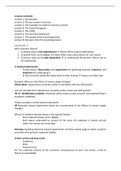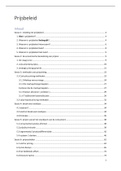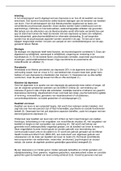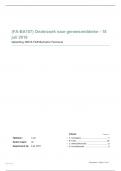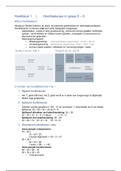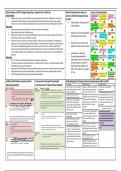Lectures schedule
Lecture 1: Introduction
Lecture 2: The pre-modern economy
Lecture 3: The transition to modern economic growth
Lecture 4: The Great Divergence
Lecture 5: The 1920s
Lecture 6: The US Great Depression
Lecture 7: The spread of the Great Depression
Lecture 8: Recovery from the Great Depression
Lecture 1
Why economic history?
1. Economic data is non-experimental history offers natural experiments.
2. Economic data can be scarce history offers more observations for rare events.
3. Economic data can be path-dependent to understand the present, history has to
be understood
1) Natural experiments
- Francis Bacon: Observation and experiment for gathering material, induction, and
deduction for elaborating it.
- In the economist toolkit the experiment is often missing history can often help.
Example: What are the effects of money supply changes?
Observation: expansionary monetary policy is correlated with low GDP growth
Can we conclude that expansionary monetary policy causes low GDP growth?
No! Identification problem: Monetary policy reacts to past, present, and expected future
economic conditions.
History provides a useful natural experiment
Repeated natural experiment allows for measurement of the effects of money supply
changes.
Effects of maritime disaster losses in the Spanish Empire
- Prices adjusted slowly (price rigidity)
- Real output contracted by around 1% for every 1% reduction in money arrivals
(short-run money non-neutrality)
Warning regarding historical natural experiments: do these results apply to other countries
and other time periods? (external validity)
2) Rare events and long cycles
- Pandemics
- Wars
- Financial crisis
For the empirical analysis of the economic consequences of such rare events a look at
history is unavoidable.
, Economic consequences of pandemics and wars
Jorda, Singh, and Taylor (2022) analyze pandemics and wars going back to medieval
times.
Predictions of a standard neoclassical growth model
- Cobb-Douglas production function:
Pandamics: Labor decreases and kapital constant
- Labor scarcity wage increase
- Abundant capital/worker low return on capital
Wars: Labor & kapital decreases
- Net effect depends on size of labor force decline vs capital destruction
longer-run consequences of pandemics and wars:
- Wars
o Real natural rate raises and then stabilizes.
o Real wages go up
- Pandemics
o Natural rate declines and furthermore rises a bit
o Real wages go up
The economic consequences of pandemics and wars
- Findings consistent with standard neoclassical growth model
- Pandemics lead to labor scarcity and abundant capital/worker
wages increase, return on capital decreases
- Wars lead to capital scarcity and a lack of capital/worker
returns to capital increase
How long do post-war economic recoveries take?
- Serveral post-WW2 recovery studies:
o Even after destruction of the proximate causes of economic growth (capital &
labor inputs), GDP per capita returns to pre-war trend within less than two
decades.
o If wars result in a deterioration of the fundamental causes of growth
(technology access) long-run growth can suffer.
Economic costs of systematic financial crises
Schularick and Taylor (2012) compile a dataset of systematic financial crises:
- Relatively few financial crisis observations post-WW2
- Income losses in financial crises versus normal recessions
Economic consequences of financial crisis
Normal recession:
Lecture 1: Introduction
Lecture 2: The pre-modern economy
Lecture 3: The transition to modern economic growth
Lecture 4: The Great Divergence
Lecture 5: The 1920s
Lecture 6: The US Great Depression
Lecture 7: The spread of the Great Depression
Lecture 8: Recovery from the Great Depression
Lecture 1
Why economic history?
1. Economic data is non-experimental history offers natural experiments.
2. Economic data can be scarce history offers more observations for rare events.
3. Economic data can be path-dependent to understand the present, history has to
be understood
1) Natural experiments
- Francis Bacon: Observation and experiment for gathering material, induction, and
deduction for elaborating it.
- In the economist toolkit the experiment is often missing history can often help.
Example: What are the effects of money supply changes?
Observation: expansionary monetary policy is correlated with low GDP growth
Can we conclude that expansionary monetary policy causes low GDP growth?
No! Identification problem: Monetary policy reacts to past, present, and expected future
economic conditions.
History provides a useful natural experiment
Repeated natural experiment allows for measurement of the effects of money supply
changes.
Effects of maritime disaster losses in the Spanish Empire
- Prices adjusted slowly (price rigidity)
- Real output contracted by around 1% for every 1% reduction in money arrivals
(short-run money non-neutrality)
Warning regarding historical natural experiments: do these results apply to other countries
and other time periods? (external validity)
2) Rare events and long cycles
- Pandemics
- Wars
- Financial crisis
For the empirical analysis of the economic consequences of such rare events a look at
history is unavoidable.
, Economic consequences of pandemics and wars
Jorda, Singh, and Taylor (2022) analyze pandemics and wars going back to medieval
times.
Predictions of a standard neoclassical growth model
- Cobb-Douglas production function:
Pandamics: Labor decreases and kapital constant
- Labor scarcity wage increase
- Abundant capital/worker low return on capital
Wars: Labor & kapital decreases
- Net effect depends on size of labor force decline vs capital destruction
longer-run consequences of pandemics and wars:
- Wars
o Real natural rate raises and then stabilizes.
o Real wages go up
- Pandemics
o Natural rate declines and furthermore rises a bit
o Real wages go up
The economic consequences of pandemics and wars
- Findings consistent with standard neoclassical growth model
- Pandemics lead to labor scarcity and abundant capital/worker
wages increase, return on capital decreases
- Wars lead to capital scarcity and a lack of capital/worker
returns to capital increase
How long do post-war economic recoveries take?
- Serveral post-WW2 recovery studies:
o Even after destruction of the proximate causes of economic growth (capital &
labor inputs), GDP per capita returns to pre-war trend within less than two
decades.
o If wars result in a deterioration of the fundamental causes of growth
(technology access) long-run growth can suffer.
Economic costs of systematic financial crises
Schularick and Taylor (2012) compile a dataset of systematic financial crises:
- Relatively few financial crisis observations post-WW2
- Income losses in financial crises versus normal recessions
Economic consequences of financial crisis
Normal recession:

